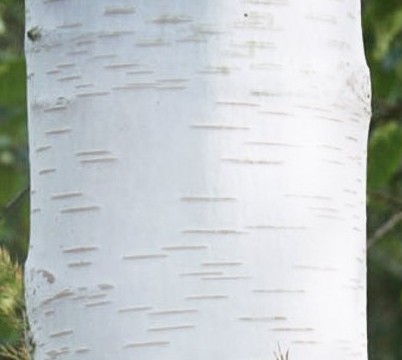 The Himalayan white birch is a deciduous tree admired for its very white paper-like bark, considered whiter than even the European white birch. Native to the Himalayas, it is a member of the birch family, Betulaceae, hat also includes alder, hazels, and hornbeam. to The bark is rich brown when the trees are young but turns white as the tree matures and provides year round interest in the garden. The dark green leaves are oblong, up to five inches long, doubly toothed, and turn buttery yellow in the fall. Light brown male catkins up to five inches long and short female catkins appear in the late spring to summer. The fruits ripen in the fall. The genus name, Betula is from Gaulish betu- meaning bitumen referring to the fact that the Gauls extracted tar from birches. The specific name, utilis, is the Latin word meaning useful and refers to the many uses of the tree. The bark has been used for paper for centuries and for such mundane things as packing, the wood in construction as well as for firewood, and the foliage for fodder. Deforestation is a problem in some areas.
The Himalayan white birch is a deciduous tree admired for its very white paper-like bark, considered whiter than even the European white birch. Native to the Himalayas, it is a member of the birch family, Betulaceae, hat also includes alder, hazels, and hornbeam. to The bark is rich brown when the trees are young but turns white as the tree matures and provides year round interest in the garden. The dark green leaves are oblong, up to five inches long, doubly toothed, and turn buttery yellow in the fall. Light brown male catkins up to five inches long and short female catkins appear in the late spring to summer. The fruits ripen in the fall. The genus name, Betula is from Gaulish betu- meaning bitumen referring to the fact that the Gauls extracted tar from birches. The specific name, utilis, is the Latin word meaning useful and refers to the many uses of the tree. The bark has been used for paper for centuries and for such mundane things as packing, the wood in construction as well as for firewood, and the foliage for fodder. Deforestation is a problem in some areas.
Type: Deciduous tree
Outstanding Feature: White bark; buttery yellow leaves in fall
Form: Pyramidal
Growth Rate: Rapid
Bloom: Long pale brown male catkins up to five inches long and short female catkins are produced in late spring to summer.
Size: 60-75’ H x 30-50’ W
Light: Full sun to light shade
Soil: Moist, well-drained
Hardiness: Zones 5-7; best in cool areas and does not tolerate heat and humidity
Care: Remove dead or deformed limbs when needed.
Pests and Diseases: Rust, leafspot, mildew, sawflies, aphids
Propagation: Softwood cuttings; grafting
Outstanding Selection:
‘Doorenbos’ (Bark peels to reveal pale orange new bark)
‘Grayswood Ghost’
‘Jermyns’ (6 ¾ “ male catkins)
‘Silver Shadow’ (Whitest of all)